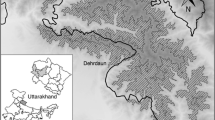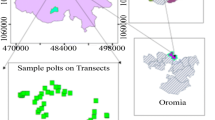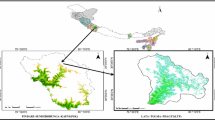Abstract
Sample plots were established in the principal forest types in the the Nevado de Toluca National Park, Mexico including those dominated by Pinus hartwegii, Abies religiosa, Quercus laurina and Alnus jorullensis. The vertical structure was defined by three strata in the coniferous forests and two strata in the broadleaved forests. Timber harvesting in Abies religiosa and Quercus laurina forests and fires generated by humans in Pinus hartwegii forests impeded the recruitment of saplings. Mature trees were also heavily impacted by logging in Pinus hartwegii forests. On the contrary, Alnus jorullensis forests were increasing due to the disturbance of Pinus and Quercus forests, as well abandoned crop lands within the park. A combination of logging, uncontrolled fire, and grazing appears to be compromising the recruitment of important tree species in this national park. These factors, together with human settlements, have also increased the proportion of early successional species. Changes in forest structure from human disturbance indicate a need to control these activities if conservation goals are not to be compromised.
Similar content being viewed by others
References
Aguirre COA, Jiménez PJ, Kramer H, Akca A. 2003. Análisis estructural de ecosistemas forestales en el Cerro del Potosí, Nuevo León, México. Ciencia UANL 6(2): 219–225.
Alvarado RD, de Bauer LI, Galindo A.J. 1993. Decline of sacred fir (Abies religiosa) in a forest park south of Mexico City. Environmental Pollution, 80(2): 105–207.
Bobbink R, Heil GW, Verduyn B. 2003. Man-induced changes in vegetation cover in the Iztaccíhuatl-Popocatepetl Region. In: Ecology and Man in Mexico Central Volcanoes Area. Dordrecht, Netherlands: Kluwer Academic Publishers, pp.49–103.
Child B. 2004. Parks in transition: Biodiversity, rural development and the bottom line. London, England: Earthscan, p.267.
CONANP. 2007. Un nuevo ciclo de vida. Logros 2007. Secretaría de Medio Ambiente y Recursos Naturale, Comisión Nacional de Áreas Naturales Protegidas, México City.
Endara AAR. 2007. Estructura forestal de Pinus hartwegii en el Parque Nacional Nevado de Toluca. Masters Thesis. Universidad Autónoma del Estado de México. México, p.76.
Ern H. 1973. Repartición, ecología e importancia económica de los bosques de coníferas en los estados mexicanos de Puebla y Tlaxcala. Com Proy Pue Tlax, 7: 21–23.
Franco MS, Regil HH, Ordoñez JAB. 2006. Dinámica de perturbaciónrecuperación de las zonas forestales en el Parque Nacional Nevado de Toluca. Madera y Bosques, 12(1): 17–28.
Gobierno del Estado de México (GEM). 1999. Programa de manejo del Parque Nacional Nevado de Toluca. México, p106.
Granados LJN. 1995. Efecto de los tratamientos del suelo sobre la regeneración natural en un bosque secundario. Tesis (Mag. Sc.). CATIE, Turrialba, Costa Rica, p109.
King B, Peralvo M. 2010. Coupling community heterogeneity and perceptions of conservation in rural South Africa. Human Ecology, 38: 265–281.
Kumar L, Ram J. 2003. Anthropogenic disturbances and plant biodiversity in forests of Uttaranchal, central Himalaya. Biodiversity and Conservation, 14: 309–331.
Lamprecht, H. 1990. Silvicultura en los trópicos. Instituto de silvicultura de la Universidad de Gottingen, Alemania, p335.
Macdonald IAW, Graber DM, DeBenedetti S, Groves RH, Fuentes ER. 1988. Introduced species in nature reserves in the Mediterranean-type climate regions of the world. Biological Conservation, 44: 37–66.
Miranda F, Hernández XE. 1985. Los tipos de vegetación en México y su clasificación. In: Xolocotzia. Tomo I. Rev. Geog. Agríc. UACH. Chapingo, Estado de México. pp 41–162.
Mittermeier RA, Myers N, Thomsen JB, da Fonseca GAB, Olivieri S. 1998. Biodiversity hotspots and major tropical wilderness areas: approaches to setting conservation priorities. Conservation Biology, 12: 516–520.
Murcia C. 1995. Edge effect in fragmented forests: implications for conservation. Ecology and Evolution, 10: 58–62.
Nagendra H, Pareeth S, Ghate R. 2006. People within parks-forest villages, land-cover change and landscape fragmentation in the Tadoba Andhari Tiger Reserve, India. Applied Geography, 26: 96–112
Pacheco P. 2006. Agricultural expansion and deforestation in lowland Bolivia: The import substitution versus the structural adjustment model. Land Use Policy, 23: 205–225.
Percy KE, Karnosky DF. 2007. Air quality in natural areas: Interface between the public, science, and regulation. Environmental Pollution, 149: 256–267.
Román CRM, Martínez VJ. 2006. Effectiveness of protected areas in mitigating fire within their boundaries: case study of Chiapas, Mexico. Conservation Biology, 20: 1074–1086.
Rzedowski J. 1978. Vegetación de México. Ed. LIMUSA. México, p431.
Sahu PK, Sagar R, Singh JS. 2008. Tropical forest structure and diversity in relation to altitude and disturbance in a Biosphere Reserve in central India. Applied Vegetation Science, 11: 461–470.
Saunders DA, Hobbs RJ, Margules CR. 1991. Biological consequences of ecosystem fragmentation: a review. Conservation Biology, 5: 18–32.
Simonetti JA, Morales M, Bustamante RO, Grez AA. 2001. Regeneración de bosques tropicales fragmentados del Beni. In: B. Mostacedo, T.S. Fredericksen (eds), “Regeneración Natural y Silvicultura en los Bosques Tropicales de Bolivia”, Santa Cruz: Bolfor, pp.139–153.
Swanson FJ, Franklin JF. 1992. New forestry principles from ecosystem analysis of pacific northwest forests. Ecological Applications, 2: 267–274.
Tabarelli M, Mantovani W, Peres CA. 1999. Effects of habitat fragmentation on plant guild structure in the montane Atlantic forest of southeastern Brazil. Biological Conservation, 91:119–127.
Timko JA, Innes JL. 2009. Evaluating ecological integrity in national parks: case studies from Canada and South Africa. Biological Conservation, 142: 676–688.
Villavicencio EL, Valdez HJI. 2003. Análisis de la estructura arbórea del sistema agroforestal rusticano de café en San Miguel, Veracruz, México. Agrociencia, 37(4): 413–423.
Valdez HJI. 2002. Aprovechamiento forestal de manglares en el estado de Nayarit, Costa Pacífica de México. Madera y bosques, Número especial, pp.129–145.
Villers RL, García del Valle L, López J. 1998. Evaluación de los bosques templados en México: una aplicación en el parque nacional Nevado de Toluca. Investigaciones Geográficas, 36: 7–21.
Vitousek PM, Mooney HA, Lubchenco J, Melillo JM. 1997. Human dominance of earth’s ecosystems. Science, 277: 494–499.
Author information
Authors and Affiliations
Corresponding author
Additional information
An erratum to this article can be found at http://dx.doi.org/10.1007/s11676-012-0116-0.
Rights and permissions
About this article
Cite this article
Agramont, A.R.E., Maass, S.F., Bernal, G.N. et al. Effect of human disturbance on the structure and regeneration of forests in the Nevado de Toluca National Park, Mexico. Journal of Forestry Research 23, 39–44 (2012). https://doi.org/10.1007/s11676-012-0226-8
Received:
Accepted:
Published:
Issue Date:
DOI: https://doi.org/10.1007/s11676-012-0226-8




